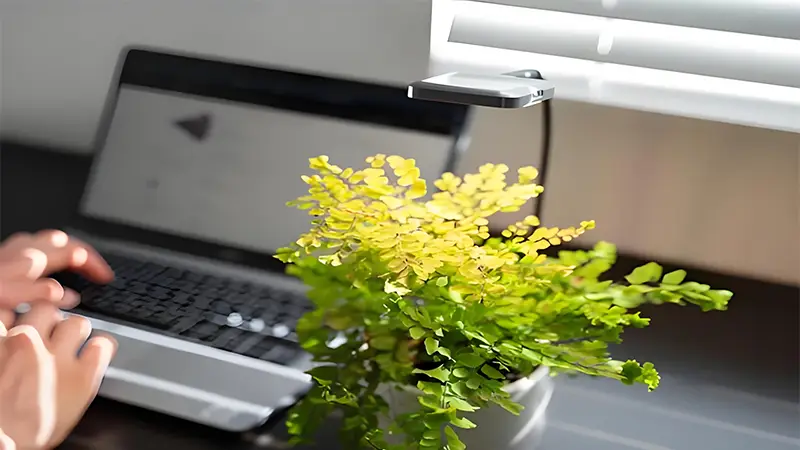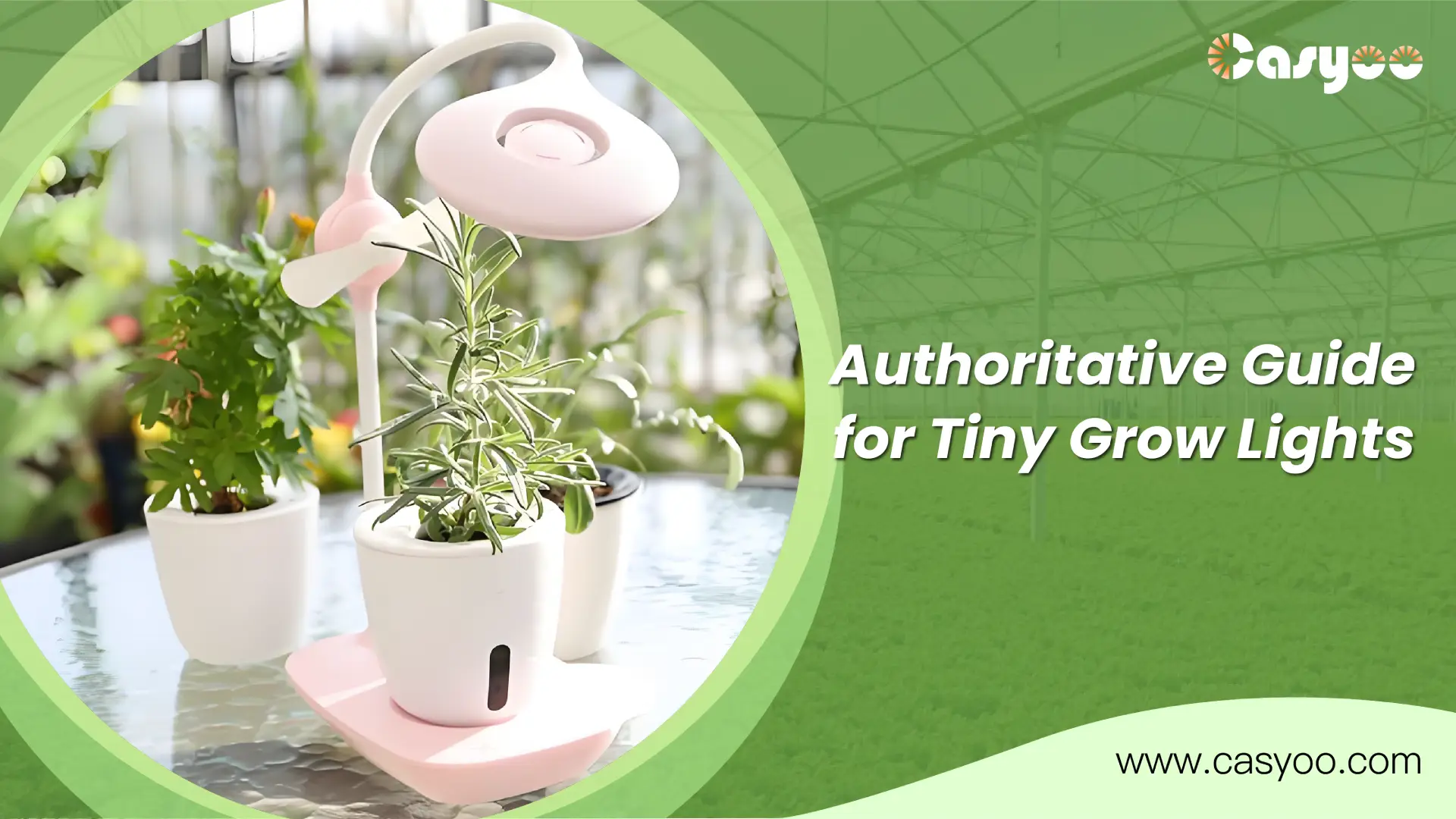What Is Tiny Grow Light?
Tiny grow light is a compact and energy-efficient lighting solution designed specifically for planting plants in small spaces such as apartments, desks, and shelves. These tiny power stations typically have a size of less than 12 inches and a power range of 3W to 45W, providing lighting for specific plants in specific environments through various styles including clip on LEDs, mini panels, and flexible gooseneck designs. Unlike traditional grow lights, tiny grow lights are more suitable for small viewing spaces, providing light for plants in confined spaces. Tiny grow lights are very suitable for amateur growers and housewives, who can grow their favorite plants (such as succulents) in any small space in the house according to their preferences. The seedlings of plants are delicate, and a high-power plant lamp can easily burn the seedlings, while a low-power micro grow light is very suitable for seedling cultivation. Tiny grow lights play an important role in home planting and seedling laboratories.
The Science Behind Tiny Grow Lights
Light Spectrum
Light is a necessary condition for plant growth. The growth of different plants has different requirements for sunlight. Plants do not absorb all sunlight, but absorb specific wavelengths of sunlight. The power of tiny grow lights is small, and the light emitted is limited. Therefore, the light emitted by tiny grow lights needs to be maximally utilized by plants. Red light (640-680nm) provides important energy for plant growth, particularly for flowering and fruiting. Blue light (425-450nm) is another important spectrum for plant growth, which is crucial for the development of plant stems and leaves. Many modern tiny grow lights contain more red and blue light in their spectra, as well as other spectra, albeit with more red and blue light. When planting specific plants, it is necessary to purchase tiny grow lights that can emit ultraviolet or far red light
Heat Management
The appearance of tiny grow lights is smaller, which makes heat dissipation more difficult compared to traditional growth lights. Thermal management of tiny grow lights is crucial. Tiny grow lights often use simple heat sinks and passive cooling designs to maintain their optimal working temperature. Lower temperatures allow the grow light to be closer to plants without burning them. The lamp beads of the tiny grow light use the latest technology, and the conversion rate of these beads can reach 40-50% efficiency. More electrical energy is converted into light energy, and less is converted into internal energy, which can greatly reduce the generation of thermal energy in the tiny grow light.
Daily Light Integral (DLI)
Daily Light Integral (DLI) refers to the total amount of light received by plants within 24 hours. Understanding DLI is crucial for the growth of indoor plants, as different plants require different lighting conditions and receive varying amounts of light each day. Low light plants like wild vegetables may only require 4-8 mol/day, while high light plants like tomatoes may require 14+mol/day. Tiny grow lights can regulate the size of DLI to better adapt to the growth of different plants.
Coverage Patterns
The coverage mode determines the output distribution efficiency within the illumination area of the tiny grow light. According to the inverse square law, the intensity of light decreases rapidly with increasing distance from the light source. The beam angle of most tiny grow lights is between 90-120 °, and the illuminated area is a cone shape. Growers need to adjust the distance between the tiny light and the plant to ensure that the light cone covers the plant better. Growers can also maximize light efficiency by using reflective surfaces around their plants. Understanding the coverage pattern is crucial for the uniform growth of indoor plants.
Different Types of Tiny Grow Lights

Mini LED panels
Mini LED panels are the most compact version of traditional growth light panels. The units of Mini LED panels are usually only 4-12 inches wide, and the panels are covered with diode arrays, which ensures uniform coverage of Mini LED panel lighting. Mini LED panels perform well in providing uniform light distribution, typically using full spectrum lighting, making them an ideal choice for small planting tents, shelves, or dedicated planting spaces.
Clip-on grow lights
Clip-on grow lights has a sturdy fixture base that can be attached to shelves, tables, and even flower pots. Clip-on grow lights is equipped with a flexible gooseneck arm, which can accurately position the lamp head. The power range of the clip-on model is usually between 3-15 watts, and its power is very small, making it very effective for individual plants or micro plant clusters. Clip on growth lights are very suitable for balconies or crowded offices. They have excellent mobility and can easily adjust the direction and height of the light.
Flexible strip lights
Flexible strip lights are suitable for specific growth spaces. These flexible LED light strips with adhesive on the back can be cut into certain sizes. Flexible strip lights are suitable for installation under shelves, next to walls, or around planting areas. The light intensity of a single light strip may not seem very strong, but it can be customized in style and lighting configuration, and most flexible strip lights are full spectrum growth lights.
Desktop grow bars
Desktop grow bars are often placed in prominent positions on the desktop, so they pay more attention to the design of their appearance. The length of desktop grow bars is usually between 8-12 inches, which is very suitable for use in offices and conference halls.
Comparison chart of types
| Feature | Mini LED Panels | Clip-On Lights | Flexible Strip Lights | Desktop Grow Bars |
| Typical Power | 15-45W | 3-15W | 2-8W per foot | 10-30W |
| Coverage Area | 1-4 sq ft | 0.5-1.5 sq ft | Varies by length | 1-3 sq ft |
| Mounting | Hanging/Stand | Clip/Clamp | Adhesive backing | Stand/Bracket |
| Price Range | $30-80 | $15-40 | $10-30 per strip | $40-100 |
| Best For | Multiple plants | Single plants/Targeted light | Custom spaces | Row arrangements |
| Spectrum Options | Full spectrum | Usually red/blue | Basic to full spectrum | Often adjustable |
| Lifespan | 25,000-50,000 hrs | 15,000-30,000 hrs | 20,000-40,000 hrs | 25,000-50,000 hrs |
| Heat Output | Low-Medium | Very Low | Very Low | Low |
| Adjustability | Height adjustable | Fully adjustable | Fixed once installed | Height/angle adjustable |
Technical Specifications That Matter
Wattage vs. actual light output
Power and actual light output are important parameters for tiny grow lights. Generally speaking, the higher the power, the greater the light output, but the light output is also related to the efficiency of converting electrical energy into light energy. The conversion rate of LED lights is between 40% and 50%, while the efficiency of other types of lights is not as high. The light output of 10W LED is the same as that of 25W fluorescent lamp. The light emitted by LED tiny grow lights is sufficient for the growth of small plants and seedlings.
Coverage area calculations
The coverage area determines the light coverage space of the tiny grow light. For small growth lamps, optimal coverage is usually achieved within the following range:
- 3-5W unit: 0.5-1 square foot
- 10-15W units: 1-2 square feet
- Unit 20-30W: 2-3 square feet
Light spectrum analysis
The different spectra demonstrate the varying quality of light received by plants. Modern tiny grow lights should provide:
- Blue light (400-500nm): 20-30% of nutritional growth yield
- Green light (500-600nm): 10-20% to better penetrate the tree crown
- Red light (600-700nm): 40-60% used for flowering and fruiting
- Optional Far Red (700-750nm): 5-10% for specific growth reactions
Power efficiency ratings
Energy efficiency rating is related to operating costs and heat management. Key indicators include:
- Photon efficiency: measured in μ mol/joules (higher is better)
- LED efficiency: The mass unit is usually 2.5-3.0 μ mol/joule
- Power factor: To achieve optimal efficiency, it should be greater than 0.90
- Input voltage range: usually 100-240V, widely used
Heat dissipation
Heat dissipation is crucial for micro growth lamps as it is an important indicator of their quality. The relevant indicators for heat dissipation include:
Working temperature range (usually 0-40 ° C)
Heat sink design and materials
Passive cooling and active cooling methods
Maximum surface temperature (should be maintained below 35 ° C)
Thermal protection function
FAQ of Tiny Grow Light
How far should tiny grow lights be from my plants?
Distance depends on light intensity and plant type:
- Seedlings: 6-8 inches
- Leafy plants: 8-12 inches
- Flowering plants: 12-18 inches
- Succulents: 4-6 inches
Always monitor plants for signs of light stress and adjust accordingly.
How many hours per day should I run my grow light?
Recommended daily light periods:
- Seedlings: 14-16 hours
- Herbs and leafy greens: 12-16 hours
- Flowering plants: 12-14 hours
- Succulents: 8-12 hours
Do tiny grow lights use a lot of electricity?
No, tiny grow lights are generally very efficient. A typical 15W LED grow light running 14 hours daily costs approximately $0.50-$1.00 per month in electricity (at $0.12/kWh).
How long do tiny grow lights last?
Quality LED grow lights typically last:
- 25,000-50,000 hours of operation
- 3-5 years of normal use
- Longer with proper care and maintenance
Light output gradually diminishes over time.
How can I maximize my grow light’s efficiency?
Tips for optimal use:
- Use reflective surfaces
- Maintain proper distances
- Clean regularly
- Group plants with similar needs
- Follow recommended light schedules
- Monitor plant response




